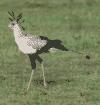- secretary bird
-
a large, long-legged, raptorial bird, Sagittarius serpentarius, of Africa, that feeds on reptiles.[1790-1800; < F secrétaire, perh. by folk etym. < Sudanese Ar sagr al-ter, equiv. to sagr hawk + al the + ter birds (collective)]
* * *
African raptor (Sagittarius serpentarius, family Sagittaridae), the only living bird of prey that hunts on foot.It has long scaly legs, a light-gray body that is 4 ft (1.2 m) long, and a 7-ft (2.1-m) wingspread. It weighs about 8 lbs (3.5 kg). Twenty black crest feathers make it appear to be carrying quill pens behind its ears. Secretary birds kill snakes (their main prey) by stamping on them, flailing them against the ground, or dropping them from aloft. They make their large stick-built nests in thorn trees. Both parents feed the offspring by regurgitation. Secretary birds are protected in most African nations. Secretary bird (Sagittarius serpentarius)© Stephen J. Krasemann/Peter Arnold, Inc.
Secretary bird (Sagittarius serpentarius)© Stephen J. Krasemann/Peter Arnold, Inc.* * *
▪ birdbird of prey (family Sagittaridae) of the dry uplands of Africa, the only living bird of prey of terrestrial habits. It is a long-legged bird, with a slender but powerful body 1.2 m (3.9 feet) long and a 2.1-metre (6.9-foot) wingspread. Twenty black crest feathers make it appear to be carrying quill pens behind its ears, as secretaries once did. It has a light gray body, black thighs and flight feathers, and white wing linings. Its head and beak resemble those of the caracara. Its tail has a pair of long central streamers. Its legs have thick scales to protect the bird from snakebite.Snakes are the main food of secretary birds, a diet supplemented by lizards, grasshoppers, mice, and birds' eggs. Secretary birds hunt on foot, in pairs or small groups that keep in contact by hooting. They kill snakes by stamping or flailing them against the ground, sometimes dropping them from aloft.Secretary birds are protected in most African nations and are sometimes tamed around farms as snake-catchers, but they have nevertheless become uncommon. The nest is large, usually built of sticks in a thorn tree. The offspring, usually two, hatch in seven weeks and are fed by both parents by regurgitation.* * *
Universalium. 2010.
